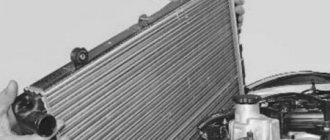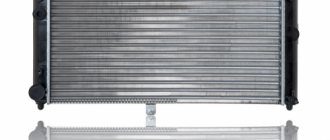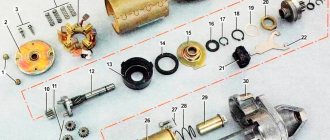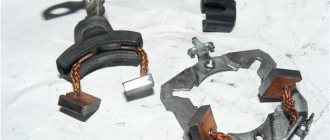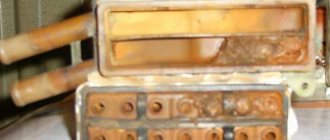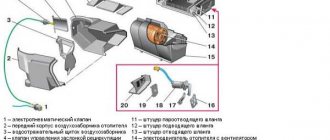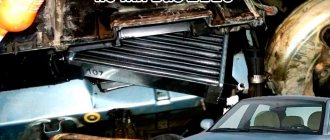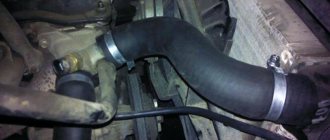If during the operation of a VAZ 2111 car you notice a leak, the smell of antifreeze or the appearance of steam from the wind blowing holes, most likely the problem is a leak in the heater radiator or in the connecting hoses of the system. For repairs, you do not have to remove anything or disassemble the dashboard. All work is performed in the engine compartment. The heater radiators of these Zhiguli models are divided into two types: new type and old. The latter were installed until 2003. The difference in repair work is small, but you need to know some nuances. This is especially true for old-style VAZ 2111 radiators.
It is important to choose a high-quality new radiator to replace the old one.
Modern stores offer a fairly wide selection of radiators for the VAZ 2111, so you need to approach your choice very responsibly. You can consult with owners of cars of this brand on specialized forums and find out which brands of products last longer.
Carrying out repairs
First you need to drain the antifreeze. Looking ahead, we note that if the drained liquid is clean, it can be refilled. You will also need a container to drain the coolant - at least four liters. You can drain the liquid from the engine block through a special plug or from the expansion tank. In the first case, you need to unscrew the expander cap and unscrew the drain plug located behind the ignition module. The second option, which involves draining the liquid from the expansion tank, requires first removing the hose from the stove.
Further, the options for replacing the old and new type heater radiators diverge. First, let's look at replacing the updated product that has been equipped with the VAZ 2111 since 2003.
How to remove and replace the heater radiator on a VAZ-2112 (old model)?
A leak of cooling fluid in the cabin is a direct prerequisite for the need to change the heating radiator, since it is already out of order.
Note that models older than 2003 have an old-style stove installed. However, towards the end of this year, the cars were already equipped with a new heater. Accordingly, they have some structural differences, and therefore are removed and installed differently.
Replacing the radiator on the VAZ-2112 stove:
- We free the system from antifreeze by draining it through the hole in the power unit block or through the expansion tank. If you choose the second option, you must remove the ignition module. Next, remove the lid from the tank, and then uncork the drain plug. If there is no sediment in the coolant, that is, it is in a clean state, it can be reused.
- It is necessary to remove the hood seal, which is located next to the frill.
- The screw fixing the frill should be unscrewed, and then the screws securing its upper part should be unscrewed.
- Loosen the clamps and remove all wires and hoses from the frill.
- Disconnect the vehicle's power supply by removing the terminals from the power source.
- On the left side of the frill there are two screws that must be unscrewed to remove the element. There is no need to remove it.
- Remove the front cover.
- You will need to remove the terminal (if any) from the liquid level control sensor in the system, as well as the steam removal hose from the expansion tank.
- Remove the hose from the front windshield washer.
- After unscrewing the four screws, you need to remove the windshield wipers with the windshield trim.
- The stove fan is dismantled, as well as the mounting brackets for its housing.
- The mounting screws are removed from the protective casings of the air filter and fan.
- It is necessary to remove the front heater blower housing and the cabin filter housing.
- The rear part of the fan shroud is removed.
- The steam outlet line and the antifreeze supply hose must be disconnected, having first loosened their fastenings.
- The heater core can now be removed.
Before installing a new radiator, it is necessary to clean its seat in the stove body. When assembling the heater in reverse order, it is very important to control the tightness of all connections and the correct location of the parts. Otherwise, the heater may simply not function, and then the entire described sequence of work will have to be done again.
Replacing a new heater radiator
The heater is attached to the body with several bolts and nuts. One screw is located in the middle at the bottom end of the windshield, two nuts are located above the exhaust manifold and one nut is in the left corner near the filter.
If your car has a rear window washer reservoir, it must be removed. The air filter is pressed against the heater with a plastic cover, which is held on by four screws. The filter must be removed.
New heater models consist of two parts connected by three screws. An air supply hose bent in the shape of the letter L is connected to the heater fan. Looking through it, you will notice a large self-tapping screw that needs to be unscrewed along with two smaller screws on the front of the heater.
We disassemble the stove into two parts, moving the right part to the right as much as possible, and removing the left one as follows: take the left side of the heater with your left hand, and the right side with your right hand and slightly scroll it upwards from you, first removing the right side, and then the entire part.
Removing the right side will not cause problems. It is necessary to dismantle the steam exhaust hose through the hole located in the right half of the sound insulation of the front panel.
The right side of the stove also consists of two parts connected by metal brackets. We remove them and the part will separate into two parts with a seal in the middle. This will give you access to the damper. It is better to use a new covered aluminum damper.
Main malfunctions of the VAZ 2110 heater
Ten, although old, is a good and simple, repairable machine. At the same time, it is quite inexpensive. It has never gone beyond the sacred club of “everyone under 500” and will never come out again, therefore it is doomed to popularity on the secondary market. The car has a number of childhood diseases that have become chronic in nearly 18 years of production. But the clinical picture of each case has been studied in detail, therefore, in the case of the stove and its main components, each breakdown has a reliable and proven repair algorithm. The VAZ 2110 heater, in principle, was designed theoretically well and at the time when the car had just begun to come off the assembly line, it was not yet the most primitive in the world.
The heater had an air recirculation system, which was supposed to promote proper ventilation and air exchange, as well as a system that accelerates the heating of the cabin in the cold season. Not everything worked as it should have, but the handy owners of dozens of them found the most original ways to extract heat from the heater, even going as far as laying special air duct hoses. Homemade air ducts were installed to prevent warm air from escaping through the cracks, of which there are a great many in the interior panels. But perhaps the biggest problem for owners of cars of all generations was the question of how to remove the heater radiator on a VAZ 2110.
Important subtleties
- When installing a plastic flap, sometimes you have to grind and adjust the flap into place so that it moves freely. It is also allowed to do a little extra work near the aluminum damper.
- After installing the damper, you should set it by hand to the cold air supply position. In this position, the heater radiator will be covered with a damper.
- Move the temperature sensor to the MIN position and turn on the ignition. The sensor will begin to rotate and take the correct position. This will make it easier for you to insert it into place, since the damper and gearbox will be in the MIN position.
- Buy a double for the washer hose, as this will simplify the installation and removal of the wind cover in the future.
As you can see, there is nothing difficult in removing the heater core if you know what to do.
Video:
Video:
Search for reasons
If the stove stops working properly, you first need to determine what could have caused the malfunction. There are not many reasons:
- Airlock. It may appear when adding antifreeze to the cooling system. To remove the plug, you need to slightly lift the front of the car and turn the engine on at idle for about 10 minutes. If there was air in the system, it will come out. Next you will need to add coolant.
- Low antifreeze level. If there is insufficient amount of antifreeze, the cooling system will not function. Over time, it becomes less, so it is necessary to add antifreeze to the required level in the tank. If the stove does not work, continue to look for the reason.
- Switch. The fan rotation speed is set by a step controller. When you turn on the stove, it is only at maximum fan speed; operation is not provided in other modes, then the most likely cause of the breakdown is the stove resistor. It will have to be replaced with a new one.
- Weak flow at maximum speed. Also, the reason for the lack of heating may be the damper opening system. In most cases, this reason appears when the filter entering the cabin is dirty. The smell of dampness in the car will help determine this.
- Flow. This is the most common type of breakdown, which occurs in almost all VAZ car models. The appearance of a leak may be associated with a faucet or stove.
- Antifreeze in the cabin. If you find a puddle of coolant on the floor near the front passenger seat or smell an unpleasant odor, you need to check the radiator, as well as the tap. Separately, it is necessary to examine all the pipes that are secured with clamps.
The pipes on the VAZ-2110 last about three years, after which the rubber begins to harden and crack. It is better not to wait for a leak to appear, but to replace the pipes much earlier than the due date.
What's the result?
As you can see, there are several main reasons why the heater in a car does not heat. If we talk specifically about the tenth VAZ model, the radiator of the VAZ 2110 stove is one of the most serious problems. It’s not even a matter of the cost of the radiator, which is quite affordable, but the need to carry out a whole series of work to remove individual elements to gain access to the radiator.
The main thing is to completely remove all air pockets from the cooling system when replacing antifreeze, and also when removing the VUT to gain access to the heater radiator, to prevent airing of the brake system. If problems with the brakes are noticeable, they must be pumped.
Causes of air in the car engine cooling system and symptoms. How to remove an air lock from the cooling system, tips and tricks.
Antifreeze boils and bubbles in the expansion tank. Causes of antifreeze or antifreeze boiling, main faults, troubleshooting, recommendations.
There is air in the engine cooling system: symptoms of airing, reasons for the formation of an air lock. How to bleed the engine cooling system.
The difference between antifreeze and antifreeze, the compatibility of different types of coolant. What to choose, antifreeze and antifreeze. How to change coolant in a car.
The engine temperature arrow jumps or jumps chaotically: the main reasons for this malfunction. Diagnosis of problems with your own hands, recommendations.
Reasons why coolant starts to leak. How to find the location of an antifreeze or antifreeze leak yourself. Useful tips and tricks.
Fault diagnosis
Before starting repairs, the defective unit is identified.
The inability to regulate the temperature of the cabin air calls for checking the dampers, control unit, and temperature sensor.
- Turn on the heating.
- Evaluate the heat of the forced air flow with your hand.
- Set the maximum value. If heat is supplied only at maximum, the sensor requires replacement.
The next step is to prevent the damper covered by the central deflectors. The standard plastic curtain becomes deformed and freezes. It is logical to install an aluminum damper.
A flow of exceptionally cold air raises the suspicion that the stove is broken. Statistics show that in nine cases out of ten, the gearmotor installed under the facing frame is to blame; it’s time to replace it. The design of VAZ 2110 gearmotors has significant differences, depending on the year of manufacture. A battery connected directly to the gear motor will help you check this element.
The noisy operation of the heating unit is annoying. The most reasonable solution is maintenance of the entire unit:
- cleaning and lubrication of the electric motor;
- applying lubricant to rubbing parts;
- replacing worn washers, use fluoroplastic washers;
- tightening fasteners.
If the antifreeze periodically leaves without obvious drips, the clamps are tightened, the fittings are dry, the pipes are intact, the windows are covered with an oily film, the radiator of the VAZ 2110 stove needs to be replaced. Before starting repairs, it is worth studying the range of heaters.
Aluminum VS Copper: which radiator to choose?
Many years of experience in operating radiators made of various materials on domestic cars (including the VAZ-2112), it was noticed that its performance is not affected by the material from which it is made. Both copper and aluminum devices heat equally well.
The only criterion when choosing a radiator is its originality, since only a serious manufacturer is capable of producing a quality product
Therefore, when purchasing a heater radiator, it is necessary to pay attention to this criterion.
So, where exactly is the radiator of the VAZ-2112 stove? In the design of the interior heating system, the radiator is located inside the heater housing, occupying a horizontal position in relation to the central panel.
